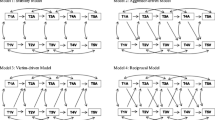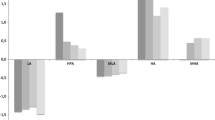Abstract
This cross-temporal meta-analysis involved 86 studies (N = 71,397) on aggression among Chinese college students conducted from 2003 to 2017. We collected articles investigating college students’ aggression using the Aggression Questionnaire. The results showed that college students’ aggression generally decreased steadily over 15 years. Compared to 2003, aggression in 2017 decreased by 1.030 standard deviations. The decline in physical aggression, verbal aggression, and hostility among college students were more rapid than anger. College students from the Eastern region of China demonstrated this decline more than those from the Center and Western regions. Both male and female college students showed decreasing aggression, and the decline was larger in males compared to females.


Similar content being viewed by others
References
Anderson, C. A., & Bushman, B. J. (2002). Human aggression. Annual Review of Psychology, 53(2), 27–51.
Buckley, K. E., & Anderson, C. A. (2006). A theoretical model of the effects and consequences of playing video games. In P. Vorderer & J. Bryant (Eds.), Playing video games: Motives, responses, and consequences (pp. 363–378). Mahwah: Erlbaum.
Buss, A. H., & Perry, M. (1992). The aggression questionnaire. Journal of Personality and Social Psychology, 63(3), 452–459.
Casas, J. F., Weigel, S. M., Crick, N. R., Ostrov, J. M., Woods, K. E., Jansen Yeh, E. A., et al. (2006). Early parenting and children’s relational and physical aggression in the preschool and home contexts. Applied Developmental Psychology, 27, 209–227.
Center for Disease Control and Prevention. (2014). Web-based injury statistics query and reporting system (WISQARS). Atlanta, GA: U.S. Department of Health and Human Services, CDC, National Center for Injury Prevention and Control. Retrieved from www.cdc.gov/ncipc/wisqars.
Chen, L., Zhang, X., & Xia, R. (2011). The relation between adolescent parent-child relationship and aggressive behavior. Studies of Psychology and Behavior, 9(3), 231–235.
Cho, H., Lee, S. K., Choi, J. S., Choi, S. W., & Kim, D. J. (2017). An exploratory study on association between Internet game contents and aggression in Korean adolescent s. Computers in Human Behavior, 73, 257–262.
Cohen, J. (1992). Statistical power analysis. Current Directions in Psychological Science, 1(3), 98–101.
Falbo, T., & Polit, D. F. (1986). Quantitative review of the only child literature: Research evidence and theory development. Psychological Bulletin, 100(2), 176–189.
Farrington, D. (2009). Conduct disorder, aggression, and delinquency. In R. Lerner & L. Steinberg (Eds.), Handbook of adolescent psychology (pp. 627–664). Hoboken: Wiley.
Gentile, D. A., Bender, P. K., & Anderson, C. A. (2017). Violent video game effects on salivary cortisol, arousal, and aggressive thoughts in children. Computers in Human Behavior, 70, 39–43.
Greitemeyer, T. (2018). The spreading impact of playing violent video games on aggression. Computers in Human Behavior, 80, 216–219.
Guo, M., Wei, G., & Zhang, Y. (2010). Anxiety trait, mental health, original family and aggression of college seniors. Chinese Journal of School Health, 31(3), 289–290.
Hilbe, C., & Sigmund, K. (2010). Incentives and opportunism: From the carrot tothe stick. Proceedings of the Royal Society B: Biological Sciences, 277(1693), 2427–2433.
Jiang, G., Chen, Y., & Ma, Y. (2014). A research on the emotional intelligence and aggressive behavior of the students from southeastern Guizhou. Journal of Kaili University, 32(3), 165–168.
Joireman, J., Anderson, J., & Strathman, A. (2003). The aggression paradox: Understanding links among aggression, sensation seeking, and the consideration of future consequences. Journal of Personality and Social Psychology, 84, 1287–1302.
Kann, L., McManus, T., Harris, W. A., et al. (2016). Youth Risk Behavior Surveillance—United States, 2015. Surveillance Summaries, 65(6), 1–174.
Krebs, D. L. (2015). Prosocial behavior. In V. Zeigler-Hill, L. L. M. Welling, & T. K. Shackelford (Eds.), Evolutionary perspectives on social psychology (pp. 231–242). Switzerland: Springer.
Lei, H. (2017). Teaching for learning: Research on learner-centered teaching (Doctoral Dissertation). China Doctoral Dissertations Full-text Database.
Lei, H., Liu, Y., Guo, C., Zhao, L., & Chen, H. (2012). On the relationship between classroom, environment and aggressive behavior: The mediating effect of the attitudes toward violence. Chinese Journal of Special Education, 19(11), 65–72.
Li, C. (2014). The changing trend of educational inequality in China (1940-2010): Reexamining the urban-rural gap on educational opportunity. Sociological Study, 2, 65–89.
Li, X., Li, Z., & Zhang, L. (2017). Relationships between social support and aggression of adolescents: The chain mediating roles of self-esteem and self-control. Psychological Development and Education, 33(2), 240–248.
Liu, W., Xu, Z., & Zou, H. (2012). The effect of parenting on social adjustment of adolescents: Personality as a moderator. Psychological Development and Education, 28(6), 625–633.
Luo, G. (2016). The relationship between aggression, coping styles, and mental health among left-behind middle school students. Mental Health Education in Primary and Secondary School, 15(2): 8-10, 15.
Moher, D., Liberati, A., Tetzlaff, J., & Altman, D. G. (2009). Preferred reporting items for systematic reviews and meta-analyses: the PRISMA statement. Annals of Internal Medicine, 151, 264–269.
Perc, M., & Szolnoki, A. (2010). Coevolutionary games—A mini review. BioSystems, 99(2), 109–125.
Pinker, K. (2012). The better angels of our nature: Why violence has declined. London: Penguin Books.
Sha, J., & Zhang, X. (2016). A cross-temporal meta-analysis of changes in chinese college students’ self-esteem: 1993-2013. Advances in Psychological Science, 24(11), 1712–1722.
Sun, X., Zhang, Y., & Zhou, Z. (2013). Children’s aggression and victimization: Mediating effect of social preference and its gender difference. Journal of Psychological Science, 36(2), 383–389.
Trouilloud, D., Sarrazin, D., Martinek, T., & Guillet, E. (2002). The influence of teacher expectations on student achievement in physical education classes: Pygmalion revisited. European Journal of Social Psychology, 32(5), 591–607.
Twenge, J. M. (2000). The age of anxiety? The birth cohort change in anxiety and neuroticism, 1952–1993. Journal of Personality and Social Psychology, 79(6), 1007–1021.
Twenge, J. M., & Im, C. (2007). Changes in the need for social approval, 1958–2001. Journal of Research in Personality, 41(1), 171–189.
Twenge, J. M., Zhang, L., & Im, C. (2004). It’s beyond my control: A cross-temporal meta-analysis of increasing externality in locus of control, 1960-2002. Personality and Social Psychology Review, 8(3), 308–319.
Xia, T., Liu, J., Gu, H., & Dong, S. (2016). The effects of interparental conflicts on adolescents’ aggressive behavior: A moderated mediation model. Psychological Development and Education, 32(4), 503–512.
Xin, Z., Niu, J., & Chi, L. (2012). Birth cohort changes in Chinese adolescents’ mental health. International Journal of Psychology, 47(4), 287–295.
Xin, Z., & Zhang, M. (2009). Changes in Chinese middle school students’ mental health (1992-2005): A cross temporal meta-analysis. Acta Psychologica Sinica, 41(1), 69–78.
Yuan, C., Chen, F., Wang, Y., & Bian, Y. (2013). A comparison of single and non-single child’s emotion adjustment. Chinese Journal of Clinical Psychology, 21(2), 296–299.
Zhou, Y. (2012). The research on school violence and coping styles in middle school students (Master’s thesis). China Master’s Theses Full-text Database.
Acknowldgments
All authors read and approved this manuscript, all the authors of this article have no conflict of interest. This research was supported by the General Project for Educational Studies of Shanghai Planning of Philosophy and Social Science (A1709); Shanghai Pujiang Program (17PJC026).
Author information
Authors and Affiliations
Contributions
Author Contributions
HL provided the idea, designed this study and wrote the manuscript, contributed to data collection. CMC was revised the language and revised the questions based on editor and reviews’ suggestions. SL contributed to provide the idea, design this study, analysis data and write the manuscript. ML was contributed the analysis data.
Corresponding author
Ethics declarations
Conflict of interest
All the authors of this article have no conflict of interest
Ethical Approval
All procedures performed in studies involving human participants were in accordance with the ethical standards of East China Normal University and with the 1964 Helsinki declaration and its later amendments or comparable ethical standards. This article does not contain any studies with animals performed by any of the authors. Informed consent was obtained from all individual participants included in the study.
Additional information
Publisher's Note
Springer Nature remains neutral with regard to jurisdictional claims in published maps and institutional affiliations.
Rights and permissions
About this article
Cite this article
Lei, H., Cheong, C.M., Li, S. et al. Birth Cohort Effects, Regions Differences, and Gender Differences in Chinese College Students’ Aggression: A Review and Synthesis. J Autism Dev Disord 49, 3695–3703 (2019). https://doi.org/10.1007/s10803-019-04081-2
Published:
Issue Date:
DOI: https://doi.org/10.1007/s10803-019-04081-2




